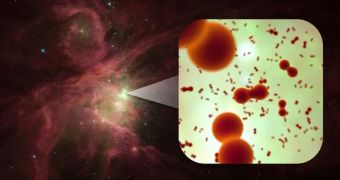Experts operating the Herschel Space Observatory announce the discovery of molecular oxygen in the Orion Nebula, a renowned stellar nursery inside the Milky Way. The European Space Agency (ESA) telescope is the first to find this form of oxygen in outer space.
Atomic oxygen has been spotted in a variety of locations many times before, but thus far experts never saw molecular oxygen in space. The new discovery was made possible by the fact that Herschel is the most sensitive observatory ever flown to space.
Astronomers have been looking for these elusive cosmic molecules for more than 230 years, and some were beginning to lose hope that they would ever find them. Scientists even began analyzing the theoretical background that led them to assume that molecular oxygen exists in space.
The work again demonstrates that patience is a virtue, especially when it comes to scientific discoveries. It took the advanced infrared detectors and spectrometers of the Herschel telescope to identify the chemical signature of molecular oxygen.
A spectrometer works by absorbing light emitted by an object, and then separating that light into its composing wavelengths. Each chemical or compound has a specific wavelength at which it “spikes.”
What this means is that if experts discover a spike in the light spectrum at a certain wavelength, then the chemical to which that spike is attached to exists in the light source. By analyzing light coming in from Orion, the group discovered the chemical signature of molecular oxygen.
The Orion Nebula is located about 1,500 light-years from our planet. The fact that it contains this type of oxygen is very interesting, considering that the compound makes up for about 20 percent of the air we breathe here on Earth.
“Oxygen gas was discovered in the 1770s, but it's taken us more than 230 years to finally say with certainty that this very simple molecule exists in space,” expert Paul Goldsmith says in a statement.
The scientist holds an appointment as a Herschel project scientist at the NASA Jet Propulsion Laboratory (JPL), in Pasadena, California. The American space agency contributed to some of the instruments on Herschel.
Goldsmith is also the lead author of a paper detailing the discoveries. The work appears in a recent issue of the esteemed Astrophysical Journal, Space reports.
“Oxygen is the third most common element in the universe and its molecular form must be abundant in space. Herschel is proving a powerful tool to probe this unsolved mystery,” Bill Danchi adds.
“The observatory gives astronomers an innovative tool to look at a whole new set of wavelengths where the tell-tale signature of oxygen may be hiding,” he goes on to say. Danchi is a Herschel program scientist based at he NASA Headquarters, in Washington, DC.

 14 DAY TRIAL //
14 DAY TRIAL //